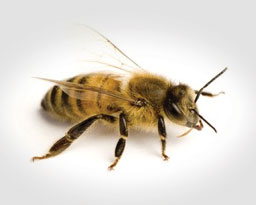FIND YOUR LOCAL
HUGHES SERVICE CENTER
Apis mellifera scutellata
Africanized "killer" bees resemble regular honey bees so much that the only way to tell them apart is by measuring their bodies. Besides different wing measurements, Africanized bees tend to be slightly smaller and darker.
Crossbreeding Western honey bees with African honey bees created these fearsome fliers. First introduced in 1950 to increase honey production in Brazil, 26 swarms escaped and spread throughout South America — arriving in North America in 1985.

| Color | Golden-yellow with darker bands of brown. |
| Legs | 6 |
| Shape | Oval; bee shape |
| Size | 1/2" |
| Antennae | True |
Killer bees originated in South America but began spreading throughout North America in the 1990s and 2000s. They can be found living in most of the Southwestern United States, recently branching out into Utah, Georgia, and Louisiana.
Africanized killer bees are highly adaptive and can nest in a wide variety of spaces. They often build colonies in unique places like tires, crates, boxes, grills, exposed tree limbs, and even holes in the ground.
Like other species of bees, Africanized bees pollinate plants. Compared to their European counterparts, they begin pollinating at much younger ages and harvest more pollen to feed their greater numbers of larvae. Africanized bees are also more sensitive to sucrose, so they tend to harvest pollen from sources with lower concentrations of sucrose.
Foraging at older ages and harvesting pollen with more concentrated nectar, the Western honey bee was selectively bred over centuries for their docile personalities, which is different from the more defensive Africanized bees that were created quickly in the 1950s. To fend off their aggression, Africanized beekeepers often used smoke, veils, and full bee suits when working with these fearsome bees.
Africanized killer bee populations are accustomed to defending against honey hunters who destroy their nests, and therefore more prone to attack. Killer bees are quicker to react to even slight disturbances and they will chase an intruder more than a quarter mile for an attack.
While killer bee incidents are less common than they were during the first wave of colonization, this reduction is largely the result of improved management techniques such as relocating nests away from human habitation, creating barriers around livestock, and educating people about the dangers of feral colonies.
Africanized killer bees differ from European honey bees in a multitude of ways. Killer bees are more likely to swarm, migrate when food supplies are low, relocate their colonies when stressed, display defensiveness when swarming, guard hives aggressively, live in underground cavities, and deploy more bees to chase threats far from the hive than other honey bees.
Though Africanized killer bees cannot survive harsh winters or dry summers, they are more resistant to parasites like mites, and fungal diseases like chalkbrood and foulbrood.
European colonies swarm just three times per year, while Africanized bees swarm more than 10 times a year, resulting in higher reproduction rates. Killer bee offspring also tend to develop and mature faster.
Additionally, killer bees are more aggressive than their Western honey bee counterparts, which were bred for centuries for their gentleness.
Deaths from killer bees are related to their persistence and numbers rather than the potency of their venom. While European honey bees sting as a last line of defense, killer bees mobilize as an entire colony if their hive is attacked. Their swarms can range from 30,000 to 100,000 bees, darkening the sky from their sheer numbers.
Known to kill horses, humans, and other large animals, killer bee victims receive ten times more stings than victims of European honey bees. Humans stung by Africanized killer bees can experience inflammation, dizziness, headaches, nausea, weakness, and vomiting. Those most at risk for death include children, elderly, and allergic individuals.
If Africanized honey bees chase you, run in a zigzag pattern and seek shelter in a house or car. If you are attacked, run away from the area with a shirt covering your head and mouth. Never stand and swat the bees.
If you are stung, remove the stinger immediately by scraping instead of pulling, and seek immediate medical attention if you have trouble breathing.
You can prevent attracting Africanized killer bees and limit the likelihood of an attack by bee-proofing structures. This includes removing debris, and closing off walls, chimneys, and plumbing gaps with mesh or caulking. Inspect your house for any holes or cracks that could potentially serve as nesting grounds for killer bees.
Vibrations from power equipment and lawn mowers can also activate Africanized bees. Always avoid swarms and nests and seek help from a professional. Most injuries are the result of humans trying to remove nests without professional help.
If Africanized bees are terrorizing your home, get some much-needed relief from Arrow by filling out the form below.
Africanized killer bees produce honey like any other bee, and they are the bee of choice in many locations, especially in Central and South America, which rank among the world leaders of honey production.
Created by biologist Warwick E. Kerr, these bees were designed to produce abundant honey in tropical climates. A single hive of killer bees can produce 100 kilograms of honey annually — far more than the 3 to 5 kilograms produced by other honey bees.
After you submit the information below, a trained professional in your area will get in touch within 1-2 business days to set up a date & time that is convenient for you.